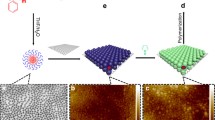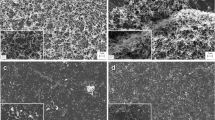Abstract
Controlling the shape of surface nanostructures is fundamental for various potential applications for examples, in water harvesting systems, liquid transportation or oil/water separation membranes. In this paper, the creation of porous surface structures is made by a process called templateless electropolymerization, in which water (H2O) is oxidized/reduced to form gas (O2/H2) bubbles onto the surfaces and acting as soft template for the polymer growth. Keeping the monomer (thieno[3,4-b]thiophene) and the substituent (pyrene) constant, we demonstrate how a flexible PEG spacer can affect the structure shape. When the PEG spacer increases, the structures change from nanotubes (1D growth) to nanoribbons (2D) and after to hollow nanospheres (3D), which also affects the wetting properties.
Similar content being viewed by others
References
Yu S, Guo Z G, Liu W M. Biomimetic transparent and superhydrophobic coatings: From nature and beyond nature. Chemical Communications, 2015, 51, 1775–1794.
Kwon O S, Park S J, Lee J S, Park E, Kim T, Park H W, You S A, Yoon H, Jang J. Multidimensional conducting polymer nanotubes for ultrasensitive chemical nerve agent sensing. Nano Letters, 2012, 12, 2797–2802.
Cheng Z J, Gao J, Jiang L. Tip geometry controls adhesive states of superhydrophobic surfaces. Langmuir, 2010, 26, 8233–8238.
Ge L, Sethi S, Ci L, Ajayan P M, Dhinojwala A. Carbon nanotube-based synthetic gecko tapes. Proceedings of the National Academy of Sciences of the United States of America, 2007, 104, 10792–10795.
Xu M, Du F, Ganguli S, Roy A, Dai L. Carbon nanotube dry adhesives with temperature-enhanced adhesion over a large temperature range. Nature Communications, 2016, 7, 13450.
Aslanidou D, Karapanagiotis I. Superhydrophobic, superoleophobic and antimicrobial coatings for the protection of silk textiles. Coatings, 2018, 8, 101.
Al-Azawi A, Latikka M, Jokinen V, Franssila S, Ras R H A. Friction and wetting transitions of magnetic droplets on micropillared superhydrophobic surfaces. Small, 2017, 13, 1700860.
Cheng Y, Yang H, Yang Y, Huang J Y, Wu K, Chen Z, Wang X Q, Lin C J, Lai Y K. Progress in TiO2 nanotube coatings for biomedical applications: A review. Journal of Materials Chemistry B, 2018, 6, 1862–1886.
Sun Z, Liao T, Liu K, Jiang L, Kim J H, Dou S X. Fly-eye inspired superhydrophobic anti-fogging inorganic nano-structures. Small, 2014, 10, 3001–3006.
Liu K S, Du J X, Wu J T, Jiang L. Superhydrophobic gecko feet with high adhesive forces towards water and their bio-inspired materials. Nanoscale, 2012, 4, 768–772.
Szczepanski C R, Darmanin T, Guittard F. Recent advances in the study and design of parahydrophobic surfaces: From natural examples to synthetic approaches. Advances in Colloid and Interface Science, 2017, 241, 37–61.
Barthlott W, Mail M, Bhushan B, Koch K. Plant surfaces: Structures and functions for biomimetic innovations. Nano-Micro Letters, 2017, 9, 23.
Lin H A, Luo S C, Zhu B, Chen C, Yamashita Y, Yu H h. Molecular or nanoscale structures? The deciding factor of surface properties on functionalized poly(3,4-ethylenedioxy thiophene) nanorod arrays. Advanced Functional Materials, 2013, 23, 3212–3219.
Lee L, Park S J. Porous anodic aluminum oxide: Anodization and templated synthesis of functional nanostructures. Chemical Reviews, 2014, 114, 7487–7556.
Yuan J Y, Qu L T, Zhang D Q, Shi G Q. Linear arrangements of polypyrrole microcontainers. Chemical Communications, 2004, 0, 994–995.
Parakhonskiy B, Andreeva D, Möhwald H, Shchukin D G. Hollow polypyrrole containers with regulated uptake/release properties. Langmuir, 2009, 25, 4780–4786.
Szczepanski C R, M’Jid I, Darmanin T, Godeau G, Guittard F. A template-free approach to nanotube-decorated polymer surfaces using 3,4-phenylenedioxythiophene (PhEDOT) monomers. Journal of Materials Chemistry A, 2016, 4, 17308–17323.
Darmanin T, Guittard F. A one-step electrodeposition of homogeneous and vertically aligned nanotubes with para-hydrophobic properties (high water adhesion). Journal of Materials Chemistry A, 2016, 4, 3197–3203.
Darmanin T, Godeau G, Guittard F, Klimarevav E L, Schewtschenko I, Perepichka I F. A templateless electropolymerization approach to porous hydrophobic nanostructures using 3,4-Phenylenedioxythiophene monomers with electron-withdrawing groups. ChemNanoMat, 2018, 4, 656–662.
Gbilimou A, Darmanin T, Godeau G, Guittard F. A templateless electropolymerization approach to nanorings using substituted 3,4-naphthalenedioxythiophene (NaPhDOT) monomers. ChemNanoMat, 2018, 4, 140–147.
Qu L T, Shi G Q, Chen F, Zhang J X. Electrochemical growth of polypyrrole microcontainers. Macromolecules, 2003, 36, 1063–1067.
Qu L T, Shi G Q, Yuan J Y, Han G Y, Chen F. Preparation of polypyrrole microstructures by direct electrochemical oxidation of pyrrole in an aqueous solution of camphorsulfonic acid. Journal of Electroanalytical Chemistry, 2004, 561, 149–156.
Kim J T, Seol S K, Je J H, Hwu Y, Margaritondo G. The microcontainer shape in electropolymerization on bubbles. Applied Physics Letters, 2009, 94, 034103.
Parakhonskiy B, Shchukin D. Polypyrrole microcontainers: Electrochemical synthesis and characterization. Langmuir, 2015, 31, 9214–9218.
Debiemme-Chouvy C. One-step electrochemical synthesis of a very thin overoxidized polypyrrole. Electrochemical and Solid State Letters, 2007, 10, E24–E26.
Debiemme-Chouvy C, Fakhry A, Pillier F. Electrosynthesis of polypyrrole nano/micro structures using an electrogenerated oriented polypyrrole nanowire array as framework. Electrochimica Acta, 2018, 268, 66–72.
Fakhry A, Cachet H, Debiemme-Chouvy C. Mechanism of formation of templateless electrogenerated polypyrrole nanostructures. Electrochimica Acta, 2015, 179, 297–303.
Fakhry A, Pillier F, Debiemme-Chouvy C. Templateless electrogeneration of polypyrrole nanostructures: Impact of the anionic composition and pH of the monomer solution. Journal of Materials Chemistry A, 2014, 2, 9859–9865.
Debiemme-Chouvy C. Template-free one-step electrochemical formation of polypyrrole nanowire array. Electrochemical Communications, 2009, 11, 298–301.
Ramos Chagas G, Darmanin T, Godeau G, Guittard F. Nanocups and hollow microspheres formed by a one-step and templateless electropolymerization of thie-no[3,4-b]thiophene derivatives as a function of the substituent. Electrochimica Acta, 2018, 269, 462–478.
Ramos Chagas G, Darmanin T, Guittard F. One-step and templateless electropolymerization process using thie-no-thiophene derivatives to develop arrays of nanotubes and tree-like structures with high water adhesion. ACS Applied Materials and Interfaces, 2016, 8, 22732–22743.
Ramos Chagas G, Akbari R, Godeau G, Mohammadizadeh M, Guittard F, Darmanin T. Electro-deposited poly(thieno[3,2-b]thiophene) films for the templateless formation of porous structures by galvanostatic and pulse deposition. ChemPlusChem, 2017, 82, 1351–1358.
Bai S L, Hu Q, Zeng Q, Wang M, Wang L S. Variations in surface morphologies, properties, and electrochemical responses to nitro-analyte by controlled electropolymerization of thiophene derivatives. ACS Applied Materials and Interfaces, 2018, 10, 11319–11327.
Thiam E h Y, Dramé A, Sow S, Sene A, Szczepanski C R, Dieng S Y, Guittard F, Darmanin T. Designing nanoporous membranes through templateless electropolymerization of thieno[3,4-b]thiophene derivatives with high water content. ACS Omega, 2019, 4, 13080–13085.
Wynberg H, Zwanenburg D J. Thieno[3,4-b]thiophene. The third thiophthene. Tetrahedron Letters, 1967, 8, 761–764.
Wang P F, Fan H J, Zhu X Z. A 2-(trifluoromethyl)thieno [3,4-b]thiophene-based small- molecule electron acceptor for polymer solar cell application. Dyes and Pigments, 2018, 155, 179–185.
Wada Y, Asada Y, Ikai T, Maeda K, Kuwabara T, Takahashi K, Kanoh S. Synthesis of thie-no[3,4-b]thiophene-based donor molecules with phenyl ester pendants for organic solar cells: Control of photovoltaic properties via single substituent replacement. ChemistrySelect, 2016, 1, 703–709.
Khodja M, El Kateb M, Beji M, Guittard F, Darmanin T. Tuning nanotubular structures by templateless electropolymerization with thieno[3,4-b]thiophene-based monomers with different substituents and water content. Journal of Colloid and Interface Science, 2020, 564, 19–27.
Sow S, Dramé A, Thiam E h Y, Orange F, Sene A, Dieng S Y, Guittard F, Darmanin T. Nanotubular structures via templateless electropolymerization using thieno[3,4-b]thiophene monomers with various substituents and polar linkers. Progress in Organic Coatings, 2020, 138, 105382.
Sane O, Diouf A, Morán Cruz G, Savina F, Méallet-Renault R, Amigoni S, Dieng S Y, Guittard F, Darmanin T. Coral-like nanostructures. Materials Today, 2019, 31, 119–120.
Bousrih I, El Kateb M, Szczepanski C R, Beji M, Guittard F, Darmanin T. A bioinspired strategy for designing well-ordered nanotubular structures by templateless electropolymerization of thie-no[3,4-b]thiophene-based monomers. Philosophical Transactions of the Royal Society A, 2020, 378, 20190450.
Acknowledgment
The group thanks Christelle Boscagli from the Centre Commun de Microscopie Appliquée (CCMA, Université Côte d’Azur) for the preparation of the substrates necessary for the SEM analyses. This work has been supported by CNRS GDR 2088 « BIOMIM ».
Author information
Authors and Affiliations
Corresponding author
Rights and permissions
About this article
Cite this article
Bousrih, I., El Kateb, M., Beji, M. et al. Surface Nanostructure Control with Poly(ethylene glycol) (PEG) Spacer by Templateless Electropolymerization. J Bionic Eng 18, 65–76 (2021). https://doi.org/10.1007/s42235-021-0003-5
Published:
Issue Date:
DOI: https://doi.org/10.1007/s42235-021-0003-5




